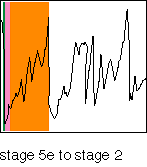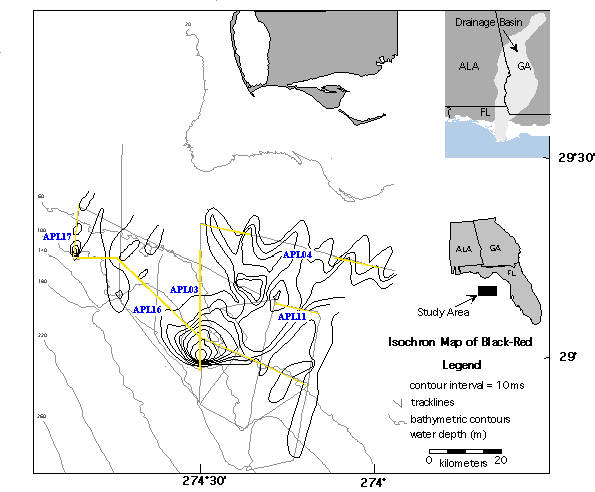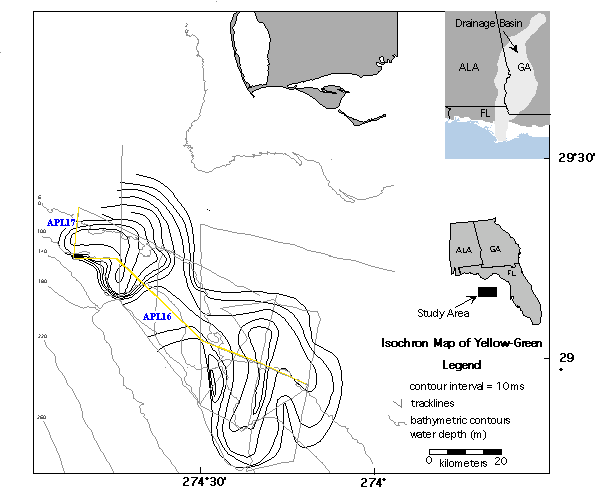Apalachicola
Highstand Systems Tract
The highstand systems tract is characterized by large-scale sandy deltas deposited on the middle/outer shelf. Seismic data suggests highstand deltas associated with the last three glacial cycles. The last two glacial cycles are best represented. Deltaic morphology varies from fluvial dominated (stage 7 to stage 6) to wave dominated (stage 5e to stage 2).


The isochron map "Isochron Map of Black-Red" illustrates thicknesses in time. The contour interval is 10 ms. This unit represents deposition between stage 5e and stage 2. The area of the delta (that portion with clinoform geometries) is approximately 23 km wide, 10 km long, and up to 80 ms thick. (The volume was estimated by approximating contour intervals with 3 diminsional geometric figures, subtracting out inside volumes, and summing.) Using a velocity of sediments equal to 1500 m/s, the sediment volume represented is approximately 44,838,572,037 m3 (45 km3).
During deposition of the delta, sea level ranged from approximately -60 meters to -90 meters (see line APL03). This is an approximation since topset beds are eroded by the stage 2 sequence boundary. According to the Chappell et al. (1996) see level proxy curve for the last glacial cycle, this represents a relative still stand in sea level between 25 ky and 75 ky. Therefore, the depositional rate can be estimated at 896,771 m3/yr (.0009 km3/yr) (.9 km3/1000 yr).


The isochron map "Isochron Map of Yellow-Green" illustrates thicknesses in time. The contour interval is 10 ms. This unit represents deposition between stage 7 and stage 6. The area of the delta (that portion with clinoform geometries) is represented by 2 distinct lobes. The area of the western lobe (that portion with clinoform geometries) is approximately 37 km wide, 34 km long, and up to 80 ms thick. The eastern lobe is approximately 38 km wide, 37 km long, and up to 40 ms thick. (The volume was estimated by approximating contour intervals with 3 diminsional geometric figures, subtracting out inside volumes, and summing.) Using a velocity of sediments equal to 1500 m/s, the sediment volume associated with the western lobe is approximately 31,600,000,000 m3 and the sediment volume associated with the eastern lobe is approximately 11,629,629,630 m3. The total sediment volume represented is approximately 43,229,629,630 m3 (43 km3).
Due to the lower accommodation, the deltas were forced to prograde the shelf rapidly in water depths between approximately -90 and -120 meters. This is an approximation and since topset beds are eroded by the stage 6 sequence boundary. According to the Haddad (1994) see level proxy curve for the last few glacial cycles, this represents deposition between 156 ky and 141 ky. Therefore, the depositional rate can be estimated at 2,881,975 m3/yr (.003 km3/yr) (3 km3/1000 yr).



Comments, questions? Contact us at
gulf@gulf.rice.edu.








